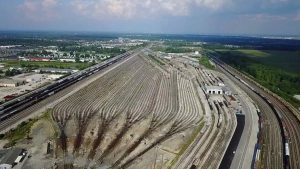Visiting Westside Yard

Big Four Yards
A rail yard is a place where work gets done. It’s a place where big, heavy, dangerous objects roll around sometimes without attachment and often without expectation. Big things happen in a rail yard, and you have to be alert. So, on any given day operating craft employees do their best to stay sharp and ready for surprises like an un-chocked cut of cars rolling out of the yards onto the mainline or any of a million other odd occurrences.
Yards come in different sizes. In Conrail’s old western division, the Big Four Yards in Avon, Indiana, just west of Indianapolis, was the largest in the division and one of the largest in the nation. The Big Four Yards was a “production” facility. Its purpose was to receive, classify, reassemble, and dispatch trains. Other yards were smaller affairs and were used to organize cuts of cars associated with one factory, grain mill, coal mine, print plant, or distillery. One of those smaller yards was the Westside Yard on Morris Street in Indianapolis primarily used to service the Ford foundry and other nearby industries. It was a small, unautomated yard, with maybe ten classification tracks, and usually had no more than two crews working on the first trick.
Every rail yard, no matter the size, has a crew breakroom. These are minimally furnished areas where operating craft employees eat their lunches, wait to be dispatched, or hang out between work assignments. In my day, a breakroom would be full of men because all operating craft employees were male. In the breakroom, you’d find men dozing, reading, eating, but always the center of breakroom culture was the quarter-ante Euchre game. If you’re unfamiliar with this speedy four-person bout of chance and skill, here’s some trivia. According to the people at Bicycle Playing Cards, Euchre is the reason why modern card decks were first packaged with jokers. But, even Euchre outgrew jokers.
The Euchre game tends to engender a great deal of chiding. Most of this is good-natured, some perfunctory based on the cards dealt, and some, let’s be generous, is raw and blue. And believe me, some brakemen-conductors are show-quality when working blue. Much of what they spout is hilarious. And, they are appreciated because they tend to keep their audience, in this case, the entire breakroom, laughing, alert and awake.
One such boisterous Euchre game was underway on a sunny summer day at the Westside Yard when I arrived with my seven-year-old daughter, Sara. I had a day off, and I wanted to take Sara on an up-close tour of railroad equipment. But first, I needed to check in at the breakroom to see what was happening.
The Westside Yard breakroom was a flimsy wooden shack just off the main switching lead and behind the yardmaster’s office. As we approached the screen door entrance, I could hear the banter and was a bit worried about exposing my precious, innocent daughter to not-so-innocent on-the-job railroaders.
We walked in, and everything got quiet as the crews shifted behavioral gears from unleashed male primates to civilized fellow fathers and upstanding citizens. Everybody smiled, I introduced Sara, and everybody politely said hello. Then, as I took Sara’s hand and started to leave, brakeman Steve Patterson, a comic pro who had missed his true calling in the performing arts, said: “Hey, Sara, have you heard this joke?”
I cringed. I was worried, but I shouldn’t have been. Steve was a pro. He had a family routine as well as his standard blue work. And, here’s the joke.
A frog walked into a bank and asked for a loan. The loan officer said, “Do you have any collateral?”
The frog answered, “All I have is this knickknack.”
The loan officer asked, “Do you have anything else?”
The frog answered, “Yes, I have a lily pad.”
And, at that, the loan officer shouted to his secretary, “Excellent. Knickknack, paddy-whack, give the frog a loan!”
I shouldn’t have worried. –SJH





